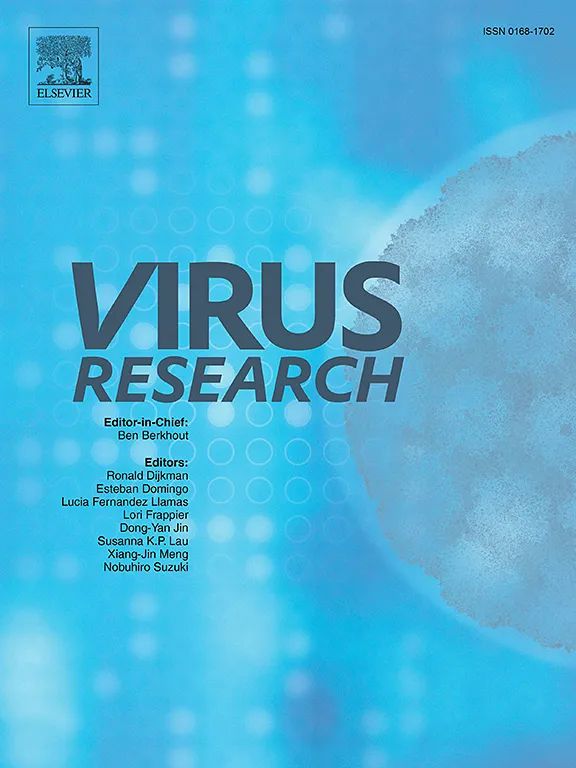Genetic features of avian influenza (A/H5N8) clade 2.3.4.4b isolated from quail in Egypt
IF 2.5
4区 医学
Q3 VIROLOGY
引用次数: 0
Abstract
Several genotypes of the highly pathogenic avian influenza (HPAI) virus H5N8 subtype within clade 2.3.4.4b continue to circulate in different species of domestic birds across Egypt. It is believed that quail contribute to virus replication and adaptation to other gallinaceous poultry species and humans. This study provides genetic characterization of the full genome of HPAI H5N8 isolated from quail in Egypt. The virus was isolated from a commercial quail farm associated with respiratory signs. To characterize the genetic features of the detected virus, gene sequencing via Sanger technology and phylogenetic analysis were performed. The results revealed high nucleotide identity with the HPAI H5N8 virus from Egypt, which has multiple basic amino acid motifs PLREKRRKR/GLF at the hemagglutinin (HA) cleavage site. Phylogenetic analysis of the eight gene segments revealed that the quail isolate is grouped with HPAI H5N8 viruses of clade 2.3.4.4b and closely related to the most recent circulating H5N8 viruses in Egypt. Whole-genome characterization revealed amino acid preferences for avian receptors with few mutations, indicating their affinity for human-like receptors and increased virulence in mammals, such as S123P, S133A, T156A and A263T in the HA gene. In addition, the sequencing results revealed a lack of markers associated with influenza antiviral resistance in the neuraminidase and matrix-2 coding proteins. The results of the present study support the spread of HPAIV H5N8 to species other than chickens in Egypt. Therefore, continuous surveillance of AIV in different bird species in Egypt followed by full genomic characterization is needed for better virus control and prevention.
从埃及鹌鹑中分离出的禽流感(A/H5N8)2.3.4.4b 支系的遗传特征
高致病性禽流感(HPAI)病毒 H5N8 亚型 2.3.4.4b 支系中的几个基因型继续在埃及各地不同种类的家禽中流行。据信,鹌鹑是病毒复制和适应其他五倍子类家禽和人类的重要因素。本研究提供了从埃及鹌鹑中分离出的高致病性禽流感 H5N8 病毒全基因组的遗传特征。该病毒是从一个出现呼吸道症状的商业鹌鹑养殖场分离出来的。为确定检测到的病毒的遗传特征,研究人员通过桑格技术进行了基因测序和系统发育分析。结果显示,该病毒与埃及高致病性禽流感 H5N8 病毒的核苷酸具有高度的一致性,后者的血凝素(HA)裂解位点有多个基本氨基酸基序 PLREKRRKR/GLF。对八个基因片段的系统进化分析表明,该鹌鹑分离物与高致病性禽流感 H5N8 病毒同属 2.3.4.4b 支系,与埃及最近流行的 H5N8 病毒关系密切。全基因组特征分析发现,该病毒的 HA 基因中的 S123P、S133A、T156A 和 A263T 等氨基酸对禽类受体具有偏好性,并有少量突变,表明其对类人受体具有亲和性,并增加了对哺乳动物的毒力。此外,测序结果显示,神经氨酸酶和基质-2 编码蛋白中缺乏与流感抗病毒性相关的标记。本研究的结果支持高致病性禽流感病毒 H5N8 在埃及向鸡以外的物种传播。因此,为了更好地控制和预防病毒,有必要对埃及不同鸟类物种中的甲型流感病毒进行持续监测,然后进行全面的基因组鉴定。
本文章由计算机程序翻译,如有差异,请以英文原文为准。
求助全文
约1分钟内获得全文
求助全文
来源期刊

Virus research
医学-病毒学
CiteScore
9.50
自引率
2.00%
发文量
239
审稿时长
43 days
期刊介绍:
Virus Research provides a means of fast publication for original papers on fundamental research in virology. Contributions on new developments concerning virus structure, replication, pathogenesis and evolution are encouraged. These include reports describing virus morphology, the function and antigenic analysis of virus structural components, virus genome structure and expression, analysis on virus replication processes, virus evolution in connection with antiviral interventions, effects of viruses on their host cells, particularly on the immune system, and the pathogenesis of virus infections, including oncogene activation and transduction.
 求助内容:
求助内容: 应助结果提醒方式:
应助结果提醒方式:


